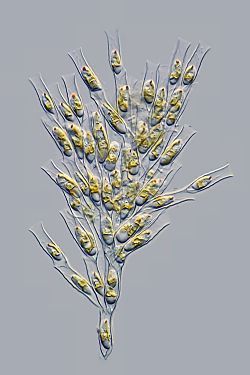Golden algae
The Chrysophyceae (golden-brown algae or golden algae) are a large group of algae found mostly in freshwater.[1]
Golden algae is also a common term. It refers to a species, Prymnesium parvum, which kills fish in large numbers (causes 'fish kills').[2]
The main type of chrysophyte cell has two specialized flagella. The active, "feathered" flagellum points toward the moving direction. The smooth passive flagellum, points in the opposite direction.
An important characteristic used to identify members of the Chrysophyceae is the presence of a siliceous cyst that is formed internally.
However, some members of the group are amoeboid (move like amoeba), and some are sessile. Unfortunately, every expert who has studied this group has come up with a different classification. It seems that their ancestor did not do photosynthesis, but later on groups separately evolved their own methods of using sunlight.[3][4]
Golden Algae Media
Pond of hikarimo ("algae of light") in Hitachi, Japan. Uncertain genus (Chromulina, Ochromonas or Chromophyton).
References
- ↑ "Introduction to the Chrysophyta". Retrieved 2009-06-13.
- ↑ "Golden Alga: Management Data Series 236: Management of Prymnesium parvum at Texas State Fish Hatcheries".
- ↑ Andersen R.A. 2004. Biology and systematics of heterokont and haptophyte algae. American Journal of Botany 91(10): 1508–1522. 2004.
- ↑ Medlin L.K. et al 1997. Phylogenetic relationships of the “golden algae” (haptophytes, heterokont chromophytes) and their plastids. Plant Systematics and Evolution (Supplement) 11: 187–219. [1]



